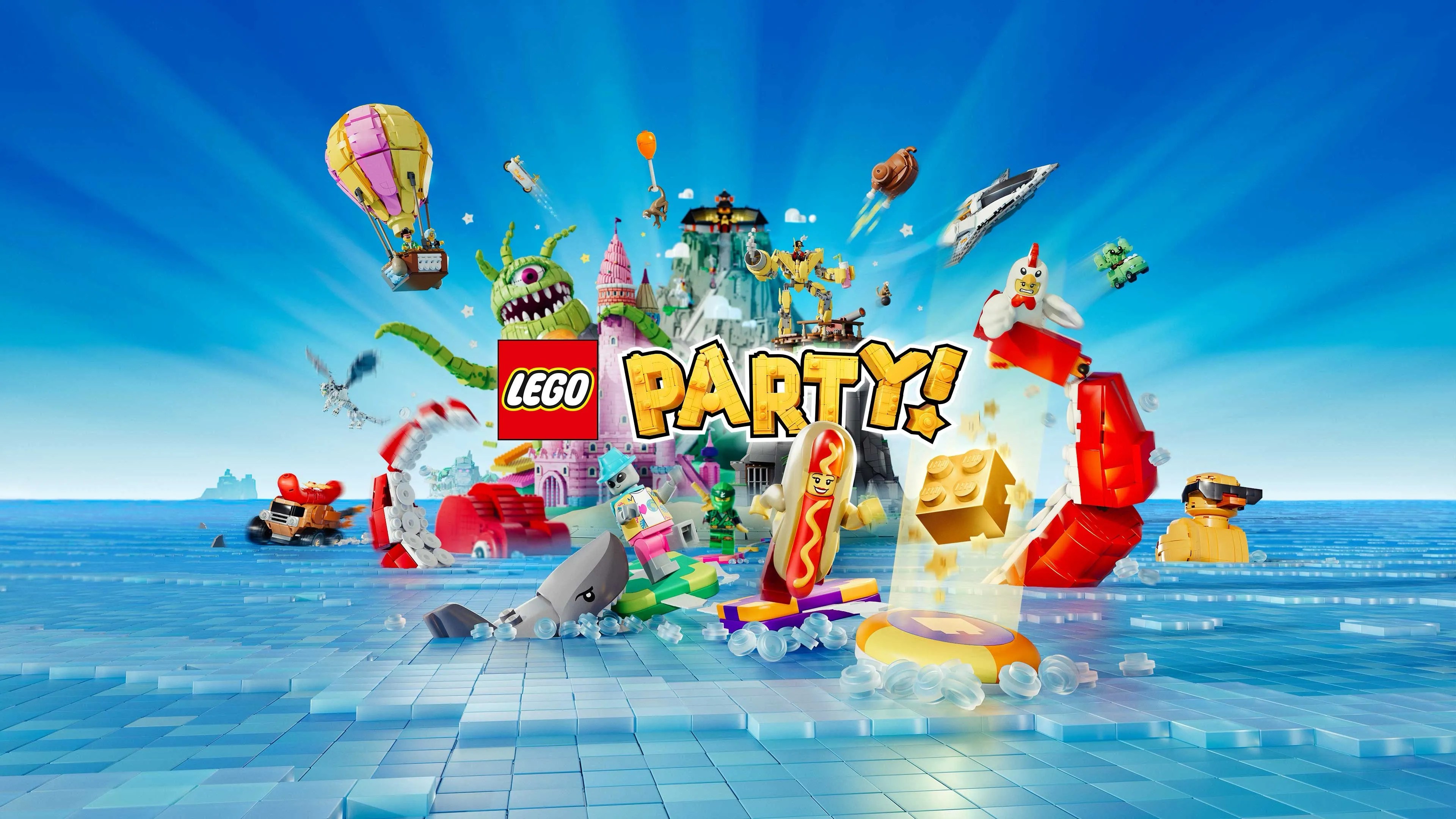
For me personally, LEGO games in general can be a bit hit-and-miss. Of course, this changed drastically once I got my hands on LEGO Voyagers earlier in September, which became my new favorite entry in the franchise and showed me just how creative, fun, and unique LEGO games truly could be if given the proper care.
With my love for LEGO in the gaming space rekindled thanks to Voyagers, I was eager to make the case that the forthcoming LEGO Party! was something we absolutely needed to cover here on DualShockers. After spending time with the title and seeing everything it had to offer, I’m so glad that I was able to go hands-on with this one.
If you’re unaware, LEGO Party! can basically be boiled down to a new Mario Party-type experience, with the main differences of course being that it’s LEGO-centric, but also that it’s available on all modern consoles and features crossplay for ease of teaming up with friends, unlike other games focused on a certain acrobatic plumber.
Sure, LEGO Party! isn’t reinventing the wheel per se, but there is something truly exciting about a new entry in a genre that I love coming to market that isn’t locked behind console exclusivity or borders between platforms that we simply don’t need anymore in the year 2025.
LEGO Party! isn’t entirely perfect, but it’s darn near close if you’re looking for that board game meets mini-game conglomerate title that you’ve likely grown to love elsewhere before. I’m excited about getting into this one, so let’s dive right in.
Is Mario In The Room With Us Right Now?
Let’s address the denim-wearing elephant in the room. Yes, LEGO Party! is extremely similar to the Mario Party franchise. While some might see it as a bit too derivative, I’d personally argue that bringing this gameplay formula to the masses after decades of it being locked away on platforms operated by The Big N is a great service to gamers in general.
LEGO Party! makes some changes that I think serve the genre wonderfully.
At its core, this is exactly what you’d expect. You and three other players (whether they be human or CPU) are navigating a board game overworld full of surprises, pitfalls, items, and events, fighting to see who can end the match with the most golden bricks collected (the LEGO Party! equivalent of power stars).
Between turns on the board, players will face-off in one of 60 mini-games, which will reward the top performers with the largest amount of studs (think coins in Mario Party). Studs are spent on golden bricks, so the more you collect, the better odds you have of gaining an advantage on the game board.
There’s a lot of strategy and good, old-fashioned griefing available during turns, as you can also steal golden bricks and studs from opponents during turns in order to change the tide of a match in an instant. While none of this should sound out of the norm if you’re a long-time Mario Party player like me, LEGO Party! makes some changes that I think serve the genre wonderfully.
For one, rounds begin with mini-games instead of ending with them. I think this is an amazing choice, because the finishing order in the mini-game determines the movement order on the board. This is awesome, since it puts a higher premium on winning a game, since rolling and moving first gets you closer to a golden brick purchase point first.
As someone that typically dominates mini-games in these types of titles, I’d often feel slighted by Mario Party in this regard. I could win every single mini-game, but if I’m still the fourth player to roll regardless, I can be hamstrung to no fault of my own at all. Getting to go first after winning a game, I’m in control of the board, and I think this is a great change. Git gud, opponents.
Players also get to vote on mini-games from a group of four options, which I highly prefer to the random selection seen in Mario Party, which all too frequently results in a weak mini-game, or one of the coin collecting options that no one actually enjoys. There are also no bonus stars/bricks given at the end of the game, so it’s truly a winner decided by performance during the match and nothing else.
Of course, winning every mini-game still doesn’t guarantee a victory, as there’s still a lot that goes into board management, item usage, and just some bona fide luck with your rolls, but bringing down the randomness and chaos a bit, rewarding actual good play, and still remaining fun and entertaining is a string that LEGO Party! manages to thread perfectly, and I love it for that.
Mini-Game Masterpieces
There are 60 mini-games in LEGO Party!, and most of them are of the 1v1v1v1 variety, as opposed to Mario Party throwing in 2v2 and 3v1 games all the time. Again, I love this. The 3v1s in Mario Party often feel extremely lopsided, and the 2v2s can be maddening if you get paired with a weaker player/CPU. 2v2s exist in LEGO Party!, but only when a specific space on the board is landed upon.
Each game is vibrant, exciting, and simply a joy to look at.
The chaos of the 1v1v1v1 format is where games like this shine, and LEGO Party! consistently nails them. I’m really not kidding when I say that there truly are hardly any mini-games within the 60 options that I think are weak. All are at least fun, reward good play, and feel original and creative even when they clearly were inspired by something else.
The charm factor here is also high, as the use of LEGOs themselves obviously comes into play with each and every experience, whether it’s just in the art inspiration, from a building perspective, or in some new, unique way you would never have even expected. Each game is vibrant, exciting, and simply a joy to look at.
Like Mario Party, you’ll also have the chance to practice mini-games before launching into the real competition, which is lovely just in case the description of the rules or controls still leaves you a little unsure. Most games are easily understood, however, and typically only require one or two controller inputs, which makes them exceptionally easy to wrap your head around while still being wonderful in execution.
There are sports competitions, vehicle races, mazes, memory games, LEGO brick sorting exercises, platforming challenges, and truly so much more in between. I think the selection may skew slightly highly towards vehicle-based games, but they’re all so fun that I personally don’t mind at all, and there are still plenty of other mini-game types as well.
…genuinely impressive just how well-curated this collection of mini-games really is.
To this point, I’ve played mostly with one human and two CPU players on “Normal” difficulty, and the balance feels great. Some games are easier than others, but as previously stated (and not trying to brag, I swear), I am just pretty good at these types of experiences. Still, it was more than welcome that I’d lose a particularly tricky game to an opponent when I deserved to.
While there are still some occasionally RNG-related elements in a mini-game here or there, it’s not even close to the same level as the RNG found all over Mario Party games. Some of you may miss the randomness since it adds to the overall chaos, but I’ll say again that I tend to prefer experiences where strong play is treated with more of a premium than anything else. LEGO Party! gives the right balance.
I find it genuinely impressive just how well-curated this collection of mini-games really is. I never had a single moment where a game was selected that I simply didn’t want to partake in, and that’s a common problem whenever I play Mario Party. I’m sure I’ll have stronger preferences as I keep playing more, I suppose. But as it stands, these games are all awesome.
Getting On The Board
LEGO Party! features four maps to play, which isn’t an exceptionally large number. While I don’t love that I keep bringing up Mario Party, it’s relevant to mention that most of those games feature more board options than this LEGO entry. Of course, quality is more important than quantity, and LEGO Party! has some great maps. But I’d be lying if I said I didn’t want more, either.
Still, the four that are here are all good-to-great board game maps. Even so, I can already tell you the definitive order in which I’d rank them, and one of the four does stand alone at the bottom as the weakest option available despite having some neat mechanical ideas. As such, the limited number of maps shrinks for me a bit further when you factor in that I probably won’t choose to play one of the boards much at all moving forward.
Here’s what’s on offer for map/board themes: Pirates, LEGO Ninjago, Outer Space, and a Theme Park. Despite having no nostalgia or love for Ninjago specifically, I’d currently claim it as my favorite of the group, with the Outer Space map following closely behind. The Pirate map is still fun, which means the Theme Park is the weakest of the group, in my opinion.
While the Theme Park looks amazing and absolutely shines in vibrance and scale compared to the others, the board layout and strategy ultimately boils down to sticking to a small circular path most of the match, which ends up making it feel pretty limited. Still, in totality, I really am more than happy with the boards here despite having a specific gripe with one of the four.
Boards are also dynamic and have several variations/iterations that will lead to different experiences match to match too, which helps with the limited overall number of four selections. Each board has spaces you can land on where you’ll get to choose a new section of the map to build. For example, on the Theme Park map, you can choose to build waterparks, haunted houses, candy castles, and various other attractions.
Whatever you choose to build will lead to new board obstacles, events, activities, and even the chance to discover more golden bricks to hoard if you play your hand correctly. This mechanic does offer some solace to anyone who might think the number of maps is too small, since there are ultimately dozens of map combinations you can experience overall.
…came away extremely impressed at the amount of variety and excitement that’s still to be found on a round-to-round basis.
There are also meta-events that take place on each map, like a space alien to fight off, Ninjago villains to thwart, or other various surprises that’ll pop up as the number of rounds played ticks higher and higher. These are all cool, and while their initial novelty will eventually wear off, they still shake up every single game in fun ways that you’ll have to consider for your ultimate gameplay strategy.
There are also shops placed around each board to purchase items, thieves you can employ to steal studs and bricks from opponents, shortcuts to discover, and many other things in between. Even if there are only four maps, I still came away extremely impressed at the amount of variety and excitement that’s still to be found on a round-to-round basis.
I should also mention that rounds are narrated by two commentators. While they are mostly hilarious, not every joke lands, and the dialogue options will repeat sooner than later. Still, the game show presentation with witty narrators that react appropriately to the on-screen action is a nice touch, even if they do end up a bit repetitive at times.
Modest, But Sufficient Modes
This style of party game has never exactly been flush with game modes, and LEGO Party! doesn’t do much to expand the scope of the typical options either. This is entirely okay, but you should still know this going in. There’s the standard “Challenge Zone” (the board game competition you know and love), a few different ways to just play mini-games, and single-player versions of a handful of mini-games to chase personal high scores.
That’s about it. There’s not a dedicated story mode, or really much of anything that lends itself to mode creativity in the genre at large. I think this is fine, and simply allows LEGO Party! to flourish as the exact multi-player game that it’s trying to be, but it’s a point to discuss nonetheless.
This means you’ll be spending nearly all your time in the standard Challenge Zone mode, which is definitely best experienced with as many humans as you can muster towards the four-player limit. While the CPU is more than adequate, the game is still at its best when you can gather three real friends to play and compete with in unison.
As mentioned before, this is made so much easier in comparison to others in the genre since LEGO Party! is multi-platform and crossplay-enabled. I’m truly hoping that means this is a game that catches on with a wide audience. There’s not a feature to matchmake with random people, but online crossplay with friends is still way more than we’re used to in the genre, so major props for that.
What’s additionally cool is that LEGO Party! also features 300 different mini figures that you can play as. While a chunk of these are unlocked from the start (more than enough), it’s nice to level-up and earn in-game currency that can be used to unlock more and more figures to add to your roster of character options.
…a multi-player party game that I’ve found myself more than thrilled with overall.
If this sounds or looks too much like cosmetic-skin-unlocking progression in a live service game like Fortnite or Fall Guys, it’s not really like that at all (thankfully). The game just gives you some nice carrots on sticks to work towards and to give as rewards for continuing to play and enjoy the game with your buddies.
While you’re more than free to simply use these 300 pre-set mini figure options, the game also allows you to mix and match different LEGO heads, faces, arms, torsos, legs, and accessories to truly customize your figure exactly how you want it. The Steam page for the game claims that this means you have over a billion combination options available, which is truly mind-boggling.
There’s a lot of charm and obvious love poured into the LEGO franchise as a whole in LEGO Party!, and it’s really nice to see this shine through in all the customization options presented here. It’s the cherry on top of a multi-player party game that I’ve found myself more than thrilled with overall, and I can’t wait to keep unlocking more figures to jump back into the game with.
Closing Comments:
LEGO Party! stands tall as one of the best games ever in the competitive board game-style genre. Sure, it’s derivative of Mario Party, but it also improves on many games in that series in a multitude of ways. Almost all of the 60 mini-games here are truly great, the game boards are creative, and the player customization options feel endless. I do wish it had a couple additional modes and maybe another game board or two, but that’s really just because I want more of this awesome title. Regardless, LEGO Party! is such a blast, and a game I sincerely hope catches on so we can keep getting more content and sequels.
- Security Camera Installation – indoor/outdoor IP CCTV systems & video analytics
- Access Control Installation – key card, fob, biometric & cloud‑based door entry
- Business Security Systems – integrated alarms, surveillance & access control
- Structured Cabling Services – voice, data & fiber infrastructure for new or existing builds
- Video Monitoring Services – 24/7 remote surveillance and analytics monitoring
Author: 360 Technology Group
























